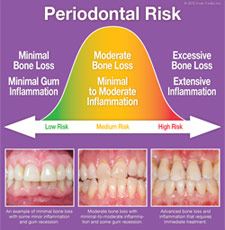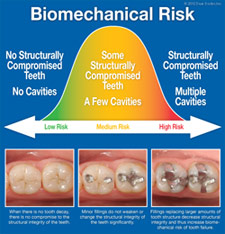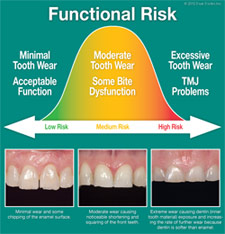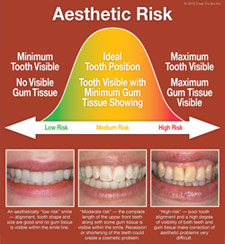Successful Dental Treatment
Getting the Best Possible Results
(Continued)
Identifying Risks To Successful Dental Treatment
In planning your dental treatment, risk level is determined from an assessment within four fundamental categories: Periodontal Risk, Biomechanical Risk, Functional Risk and Aesthetic Risk.
Periodontal Risk
 |
| Click to enlarge |
 |
| Click to enlarge |
 |
| Click to enlarge |
 |
| Click to enlarge |
This comprises threats to structures that support your teeth, particularly bone. If bone is being or has been lost, you are at greater risk for tooth loss from periodontal (gum) disease. This risk may be influenced by systemic (general) health conditions such as diabetes and habits such as smoking. Risk can be managed by changing personal behaviors and ensuring optimal oral hygiene. Periodontal risk (“peri” – around; “odont” – tooth) can also be affected by inflammatory conditions such as cardiovascular (“cardio” – heart; “vascular” – blood vessel) disease, and vice versa. These health conditions should be controlled with the help of your physician. For those who are highly susceptible to periodontal disease, the risk cannot always be completely eliminated; treatment decisions must take this into consideration.
Biomechanical Risk
This involves the structural integrity of the teeth — past tooth structure loss due to decay (cavities), acid erosion, and fracture, as well as susceptibility to decay. Certainly the higher your decay activity or rate, the higher the risk of structural (tooth) compromise. Addressing bacterial, dietary, salivary (dry mouth) and other known risk factors can help minimize the risk for future decay. If teeth are severely compromised by tooth decay, their removal and replacement with dental implants may be recommended to lower biomechanical risk.
Functional Risk
This relates to how teeth, muscles and jaw joints are functioning and wearing. This assessment involves categorizing your bite — the way the teeth fit together and how you chew. It involves assessing muscle forces generated during biting, which can affect the way the teeth wear, cause tooth looseness by affecting their attachment to the bone, and/or affect the temporomandibular (jaw) joint (TMJ). For example, if you have worn your teeth excessively it is important to figure out why your teeth have worn and look the way they do. If the problem is not addressed, the same wear patterns can result in breakage of the teeth and damage to tooth restorations (crowns or veneers, for example). Moving, reshaping, or restoring the teeth might accomplish this but the important part is to establish and address functional risk before proceeding with any treatment. For a small percentage of people functional risk cannot be eliminated, in which case an oral appliance such as an occlusal (bite) guard should be used to protect teeth during stressful periods and/or when sleeping.
Aesthetic Risk
This is really about how your teeth look and thus the risk tends to be more subjective. It is based on an assessment of “tooth display” and (ideal) tooth position in relation to your face. Aesthetic risk is higher in those who display more of their teeth and gum tissue when smiling. In these cases, any aesthetic issues affecting teeth and gums — gum recession, for example — are that much more visible and influential to your smile. Because aesthetic value is subjective, your personal opinion will be a large consideration.
Understanding Treatment as it Relates to Your Risk Assessment
Today, we have the blessings of modern technology and data analysis of your clinical situation to assess your needs and formulate a treatment plan with realistic goals in mind. Using a risk-based assessment system helps ensure an accurate diagnosis and a treatment plan with reasonable and achievable goals. We need to place emphasis on the need to prevent oral health problems from progressing so you can receive the best and longest-lasting care possible at the lowest financial, as well as psychological and emotional, cost.
Continue Reading
In the next article we introduce you to a real-life case of a young woman who wanted to improve her smile along with her oral health. Using the evaluation system just described, Dr. Kois planned her treatment by identifying how her risk factors would influence her chances for success with various treatment options. Together, they decided how best to proceed with a very successful treatment plan. This is just the first in an ongoing “Patient Care” series in which Dear Doctor will present examples of how patients with different needs are evaluated and how their unique risk factors influence treatment choices and future success. Read Planning Successful Dental Treatment





